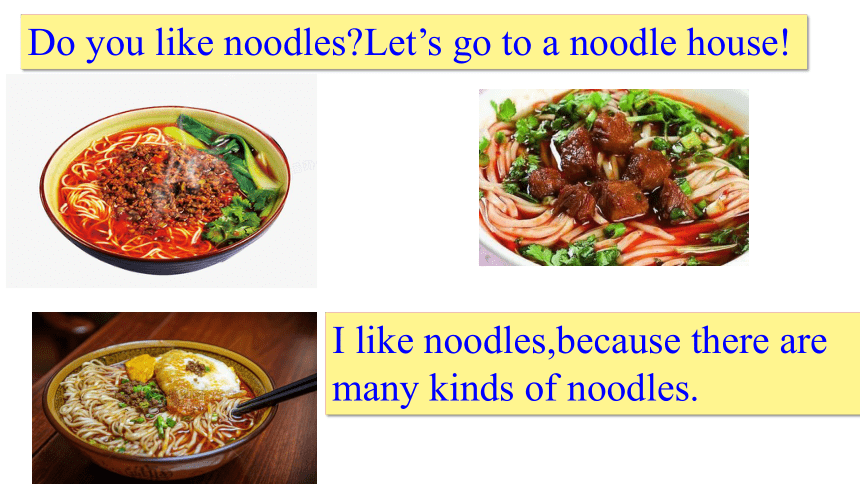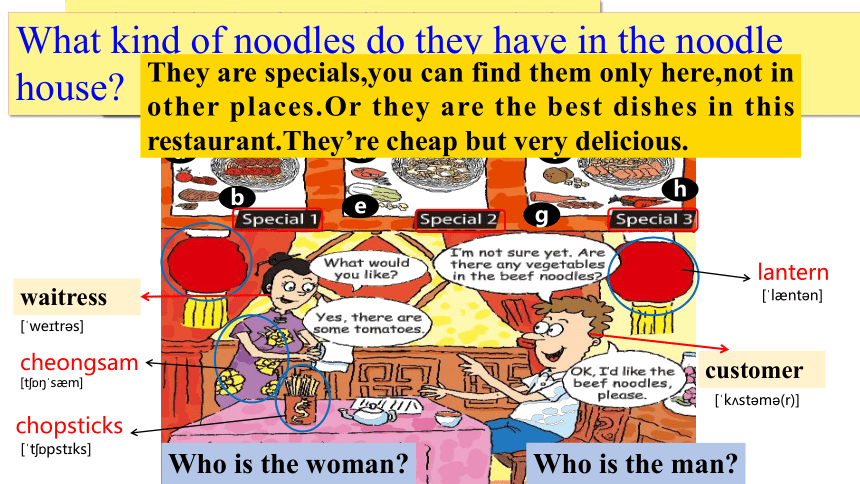2021-2022学年人教版七年级英语下册Unit10SectionA1a-1c课件(15张)
文档属性
| 名称 | 2021-2022学年人教版七年级英语下册Unit10SectionA1a-1c课件(15张) |  | |
| 格式 | pptx | ||
| 文件大小 | 10.8MB | ||
| 资源类型 | 教案 | ||
| 版本资源 | 人教新目标(Go for it)版 | ||
| 科目 | 英语 | ||
| 更新时间 | 2022-05-23 15:44:25 | ||
图片预览







文档简介
(共15张PPT)
Unit 10 I’d like some noodles.
Section A 1a-1c
Teaching Goals
(教学目标)
知识与技能:学生通过识图了解点餐的情境,能就食物进行询问,并能正确使用What would you like 点餐;学习有关食物的名称,同时分辨可数名词和不可数名词。
学习策略:训练学生仔细地观察图片并获取图片中的信息;学生能通过听力和口语训练来熟悉并掌握如何使用目标语言。
文化意识:西方人在餐馆点餐时的社交礼仪及表达方式有所不同;了解在点餐时顾客和服务员所运用的不同表达方式。
情感态度:了解国外中餐馆的特色,以中餐走向世界为傲。
思维训练:1a主题图展示了一个中式面馆,有助于提高学生在这个特定的情境下推断对话人物的关系及对话内容的思维能力。
Analysis of Teaching Materials
(教材分析)
1a:视觉输入,通过主题图导入本节课的语境和话题:在餐馆点餐;引入本节课的重点词汇:食物名称。
1b:通过听力输入本节课的目标语言What would you like I’d like...Are there any... ;了解听力中special的内涵;再次巩固本节课中上述句型的含义。
1c:运用本节课的重点词汇和核心句型进行服务员和顾客的点餐会话。
各环节之间的联系:
导入——听力输入——语言输出
potatoes [p te t ]
tomatoes 英[t mɑ t ]
美[t me to ]
carrots
[ k r t]
peas [pi ]
radishes
[ r d ]
lettuce [ let s]
cabbage [ k b d ]
vegetables
beef [bi f]
pork [p k]
chicken [ t k n]
mutton [ m tn]
noodles [ nud lz]
milk [m lk]
porridge[ p r d ]
others
meat
Which one do you like best
I like noodles,because there are many kinds of noodles.
Do you like noodles Let’s go to a noodle house!
a
b
c
d
e
f
g
h
What kind of noodle house is it
Chinese noodle house.
How do you know
Who is the woman
Who is the man
waitress
customer
What kind of noodles do they have in the noodle house
They are specials,you can find them only here,not in other places.Or they are the best dishes in this restaurant.They’re cheap but very delicious.
lantern
[ l nt n]
cheongsam
[t s m]
chopsticks
[ t pst ks]
[ we tr s]
[ k st m (r)]
What does Special 1/2/3 have
Special 1 has________ and _________.
Special 2 has________ and _________.
Special 3 has________ and _________.
beef
tomatoes
chicken
cabbage
mutton
carrots
beef noodles with tomatoes
chicken noodles with cabbage
mutton noodles with potatoes
beef and tomato noodles
cabbage and chicken noodles
mutton and potato noodles
=noodles with beef and tomatoes
=noodles with cabbages and chicken
=noodles with mutton and potatoes
1. mutton __
2. beef __
3. noodles __
4. chicken __
5. cabbage __
6. potatoes __
7. tomatoes __
8. carrots __
Match the words with the foods.
g
b
c
d
e
f
a
h
1a
a
b
c
d
e
f
g
h
order the food
Listen and check (√) the noodles that the person orders.
1b
___ Special 1 ___ Special 2 ___ Special 3
一定要捕捉关键词哦!
√
What kind of noodles would the man like
Special 1 is beef noodles with tomatoes in it.
Waitress: What would you like
Customer: I’m not sure yet. Are there any vegetables in the beef
noodles
Waitress: Yes, there are some tomatoes.
Customer: OK, I’d like the beef noodles, please.
a
b
c
d
e
f
g
h
Practice the conversation in 1a with your partner. Then make your own conversations.
注意模仿1b中的语音语调哦!
1c
Pair work
Talk about what noodles do you like
Waitress: What would you like
Customer: I’m not sure yet. Are there any… in the...
Waitress: Yes, there are/ is ... Would you like…
Customer: Yes, I’d like…
would like
1. What would you like 您需要什么? (教材P55 图片文字)
would like和want表示“要;想要”,但两者语气上差别较大。前者礼貌委婉、正式规范,后者直接、非正式且随意。
I’d like a cup of black tea with milk, please. 请给我来杯加奶的红茶。
I want some hot tea, Mom. 妈妈,我想喝些热茶。
What do you want to eat today, children 孩子们,今天你们
想吃些什么?
What would you like to order, sir 先生,您想点些什么?
Point
Language points
special n.特色菜;特价品 adj. 特别的;特殊的
2. Special 1 1号特色面 (教材P55 1b)
【用法详解】(1) special 在此处作名词,意为“特色菜;特价品”。
Special 2 is my favorite. 2号特色菜是我最喜欢的。
What is your special today 今天你们的特价品是什么
(2) special 还可作形容词,意为“特别的;特殊的”。其副词形式为 specially,意为“专门地;特意;特别”。
It’s a special day for me. 今天对我来说是个特殊的日子。
We come specially to see you. 我们特意来看你。
Point
Language points
Homework
询问父母喜欢吃的面条的种类,然后把你们的对话写下来,并试着亲自下厨为他们做一碗爱心面条。
Unit 10 I’d like some noodles.
Section A 1a-1c
Teaching Goals
(教学目标)
知识与技能:学生通过识图了解点餐的情境,能就食物进行询问,并能正确使用What would you like 点餐;学习有关食物的名称,同时分辨可数名词和不可数名词。
学习策略:训练学生仔细地观察图片并获取图片中的信息;学生能通过听力和口语训练来熟悉并掌握如何使用目标语言。
文化意识:西方人在餐馆点餐时的社交礼仪及表达方式有所不同;了解在点餐时顾客和服务员所运用的不同表达方式。
情感态度:了解国外中餐馆的特色,以中餐走向世界为傲。
思维训练:1a主题图展示了一个中式面馆,有助于提高学生在这个特定的情境下推断对话人物的关系及对话内容的思维能力。
Analysis of Teaching Materials
(教材分析)
1a:视觉输入,通过主题图导入本节课的语境和话题:在餐馆点餐;引入本节课的重点词汇:食物名称。
1b:通过听力输入本节课的目标语言What would you like I’d like...Are there any... ;了解听力中special的内涵;再次巩固本节课中上述句型的含义。
1c:运用本节课的重点词汇和核心句型进行服务员和顾客的点餐会话。
各环节之间的联系:
导入——听力输入——语言输出
potatoes [p te t ]
tomatoes 英[t mɑ t ]
美[t me to ]
carrots
[ k r t]
peas [pi ]
radishes
[ r d ]
lettuce [ let s]
cabbage [ k b d ]
vegetables
beef [bi f]
pork [p k]
chicken [ t k n]
mutton [ m tn]
noodles [ nud lz]
milk [m lk]
porridge[ p r d ]
others
meat
Which one do you like best
I like noodles,because there are many kinds of noodles.
Do you like noodles Let’s go to a noodle house!
a
b
c
d
e
f
g
h
What kind of noodle house is it
Chinese noodle house.
How do you know
Who is the woman
Who is the man
waitress
customer
What kind of noodles do they have in the noodle house
They are specials,you can find them only here,not in other places.Or they are the best dishes in this restaurant.They’re cheap but very delicious.
lantern
[ l nt n]
cheongsam
[t s m]
chopsticks
[ t pst ks]
[ we tr s]
[ k st m (r)]
What does Special 1/2/3 have
Special 1 has________ and _________.
Special 2 has________ and _________.
Special 3 has________ and _________.
beef
tomatoes
chicken
cabbage
mutton
carrots
beef noodles with tomatoes
chicken noodles with cabbage
mutton noodles with potatoes
beef and tomato noodles
cabbage and chicken noodles
mutton and potato noodles
=noodles with beef and tomatoes
=noodles with cabbages and chicken
=noodles with mutton and potatoes
1. mutton __
2. beef __
3. noodles __
4. chicken __
5. cabbage __
6. potatoes __
7. tomatoes __
8. carrots __
Match the words with the foods.
g
b
c
d
e
f
a
h
1a
a
b
c
d
e
f
g
h
order the food
Listen and check (√) the noodles that the person orders.
1b
___ Special 1 ___ Special 2 ___ Special 3
一定要捕捉关键词哦!
√
What kind of noodles would the man like
Special 1 is beef noodles with tomatoes in it.
Waitress: What would you like
Customer: I’m not sure yet. Are there any vegetables in the beef
noodles
Waitress: Yes, there are some tomatoes.
Customer: OK, I’d like the beef noodles, please.
a
b
c
d
e
f
g
h
Practice the conversation in 1a with your partner. Then make your own conversations.
注意模仿1b中的语音语调哦!
1c
Pair work
Talk about what noodles do you like
Waitress: What would you like
Customer: I’m not sure yet. Are there any… in the...
Waitress: Yes, there are/ is ... Would you like…
Customer: Yes, I’d like…
would like
1. What would you like 您需要什么? (教材P55 图片文字)
would like和want表示“要;想要”,但两者语气上差别较大。前者礼貌委婉、正式规范,后者直接、非正式且随意。
I’d like a cup of black tea with milk, please. 请给我来杯加奶的红茶。
I want some hot tea, Mom. 妈妈,我想喝些热茶。
What do you want to eat today, children 孩子们,今天你们
想吃些什么?
What would you like to order, sir 先生,您想点些什么?
Point
Language points
special n.特色菜;特价品 adj. 特别的;特殊的
2. Special 1 1号特色面 (教材P55 1b)
【用法详解】(1) special 在此处作名词,意为“特色菜;特价品”。
Special 2 is my favorite. 2号特色菜是我最喜欢的。
What is your special today 今天你们的特价品是什么
(2) special 还可作形容词,意为“特别的;特殊的”。其副词形式为 specially,意为“专门地;特意;特别”。
It’s a special day for me. 今天对我来说是个特殊的日子。
We come specially to see you. 我们特意来看你。
Point
Language points
Homework
询问父母喜欢吃的面条的种类,然后把你们的对话写下来,并试着亲自下厨为他们做一碗爱心面条。
同课章节目录
- Unit 1 Can you play the guitar?
- Section A
- Section B
- Unit 2 What time do you go to school?
- Section A
- Section B
- Unit 3 How do you get to school?
- Section A
- Section B
- Unit 4 Don't eat in class.
- Section A
- Section B
- Unit 5 Why do you like pandas?
- Section A
- Section B
- Unit 6 I'm watching TV.
- Section A
- Section B
- Review of Units 1-6
- Unit 7 It's raining!
- Section A
- Section B
- Unit 8 Is there a post office near here?
- Section A
- Section B
- Unit 9 What does he look like?
- Section A
- Section B
- Unit 10 I'd like some noodles.
- Section A
- Section B
- Unit 11 How was your school trip?
- Section A
- Section B
- Unit 12 What did you do last weekend?
- Section A
- Section B
